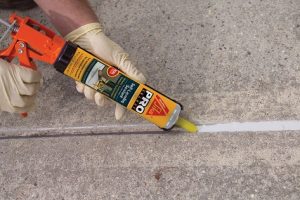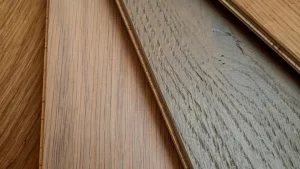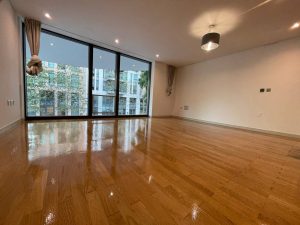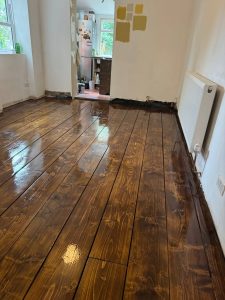How to Choose the Right Sealant for Your Sanded Floors

Choosing the right sealant for your sanded floors is crucial for protecting the wood and enhancing its natural beauty. With various options available, selecting the best sealant for your needs can be challenging. This guide will help you understand the different types of sealants and provide expert tips to make the best choice for your London home.
Why Sealing Your Floors is Important
Sealing your floors offers several benefits:
- Protection: Sealants protect wood from moisture, stains, and wear, extending the lifespan of your floors.
- Enhancement: A good sealant enhances the natural beauty of the wood, highlighting its grain and colour.
- Durability: Sealed floors are more resistant to scratches and dents, making them easier to maintain.
Types of Sealants
There are several types of sealants to choose from, each with its own advantages and considerations:
1. Polyurethane
Polyurethane is one of the most popular sealants for hardwood floors. It comes in two types: oil-based and water-based.
- Oil-Based Polyurethane: Offers a rich, warm finish and is highly durable. It is ideal for high-traffic areas but has a longer drying time and a stronger odour.
- Water-Based Polyurethane: Dries quickly and has a low odour. It provides a clear finish that doesn’t yellow over time, making it suitable for lighter woods. However, it may not be as durable as oil-based options.
2. Hardwax Oil
Hardwax oil combines the benefits of oil and wax finishes. It penetrates the wood to protect from within while providing a natural, matte finish on the surface. Hardwax oil is easy to maintain and repair but may require more frequent reapplication than polyurethane.
3. Shellac
Shellac is a traditional, natural sealant made from resin and alcohol. It offers a warm, glossy finish and is eco-friendly. However, it is less durable than modern sealants and may require more maintenance.
4. Varnish
Varnish provides a hard, protective coating that enhances the wood’s appearance. It comes in various sheens, from matte to high gloss. Varnish is durable and resistant to scratches and stains but can be more challenging to apply evenly.
Factors to Consider When Choosing a Sealant
When selecting a sealant, consider the following factors:
1. Wood Type

The type of wood you are sealing will influence your choice of sealant. Lighter woods may benefit from clear, non-yellowing sealants, while darker woods can handle richer finishes.
2. Traffic Level
Consider the amount of foot traffic the area receives. High-traffic areas, like hallways and living rooms, require more durable sealants, such as oil-based polyurethane.
3. Desired Finish
Think about the finish you want to achieve. Matte finishes provide a natural look, while glossy finishes offer a more polished appearance. Choose a sealant that aligns with your aesthetic preferences.
4. Drying Time
Drying time can vary significantly between sealants. Water-based polyurethane dries quickly, while oil-based options take longer. Consider your timeline and the convenience of application when choosing a sealant.
5. Environmental Impact
If eco-friendliness is a priority, opt for natural sealants like shellac or water-based polyurethane, which have lower VOC (volatile organic compounds) emissions.
Application Tips
Proper application is key to achieving the best results with your chosen sealant:
- Preparation: Ensure the floor is clean, dry, and free of dust before applying the sealant.
- Stir, Don’t Shake: Stir the sealant thoroughly to avoid bubbles that can affect the finish.
- Apply Evenly: Use a high-quality brush, roller, or applicator pad to apply the sealant evenly. Follow the wood grain to ensure a smooth finish.
- Multiple Coats: Apply multiple thin coats rather than one thick coat. Allow each coat to dry completely and lightly sand between coats for the best results.
- Ventilation: Ensure the room is well-ventilated during application and drying to avoid inhaling fumes and to help the sealant cure properly.
Conclusion
Choosing the right sealant for your sanded floors is essential for protecting and enhancing their beauty. By considering factors such as wood type, traffic level, desired finish, drying time, and environmental impact, you can select the best sealant for your needs. Proper application will ensure a durable and attractive finish, adding value and longevity to your London home. For professional floor sanding and sealing services, contact our experienced team today. We are dedicated to providing top-quality results for your home improvement projects.







Sand Hard Wood Flooring
Even the best wood floors are subject to damage. With time, hardwood floors scratch, dull,[Read more...]
Gallery 01 – Sand and oak stain and varnish finish
[Read more...]
Sep
How to Achieve a Smooth Finish on Your Sanded Floors
How to Achieve a Smooth Finish on Your Sanded Floors Expert Tips for Professional-Quality[Read more...]
Pet-Friendly Floor Sanding Solutions
As a pet owner, maintaining beautiful wooden floors while ensuring the safety and comfort of[Read more...]
Why Professional Floor Sanding is Worth the Investment
Why Professional Floor Sanding is Worth the Investment Discover the Benefits of Hiring Experts[Read more...]
Floor sanding and renovation and installation services in Essex
Essex: A County of Charm and Diversity Essex is a historic and picturesque county located[Read more...]
How to Choose the Right Sandpaper for Floor Sanding
How to Choose the Right Sandpaper for Floor Sanding Ensure a Smooth and Professional[Read more...]
The Impact of Floor Sanding on Indoor Air Quality
The Impact of Floor Sanding on Indoor Air Quality Maintain a Healthy Home Environment[Read more...]
Gallery 07 – Pine floor board
[Read more...]
How to Deal with High Traffic Areas on Sanded Floors
How to Deal with High Traffic Areas on Sanded Floors Protect and Maintain[Read more...]